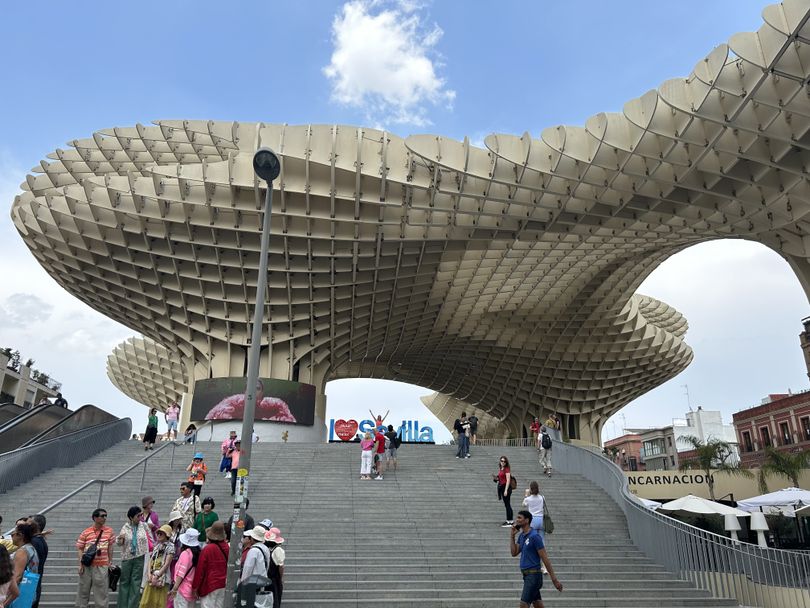Sevilla: So much to see, so little time

One of the best things about traveling abroad is the opportunity to eat good pastries, particularly croissants. I’ve eaten those heavenly bits of buttery, flaky dough in cities as diverse as Copenhagen, Florence, Zurich, Paris, Berlin and even Buenos Aires, Sydney … and Beijing.
So, on my first full day in Sevilla, Spain, I was on the hunt for whatever the Spanish version would be. In my halting Spanish, I asked the woman working the desk at the Hotel Casa 1800 where I might find a good pastry shop. (It wasn’t necessary to speak Spanish because she spoke perfect English. But I wanted to practice, and she had the patience of someone accustomed to addressing tourists who speak her native language like a third-grader).
She directed me to La Canasta Sevilla, which was just a few blocks away. So, I set out, careful to take in the directions so I wouldn’t get lost – something that I’ve been known to do in certain cities (Fez in Morocco, for example).
And the hotel employee was correct. La Canasta was bustling, even at 8 a.m. Of course, the place doesn’t offer just pastries. The coffee isn’t bad either, along with the various breads and healthy food options. I bought three fresh-from-the-oven croissants and ended up devouring one on the way back to the hotel, where I was able to enjoy my coffee free of charge in the lobby.
In the early afternoon, we showed up at the Real Alcazar – the ancient Spanish royal palace – at our appointed time. It being one of Sevilla’s must-see sites, we weren’t surprised at the long line of other ticketholders standing in the bright sunshine. A bit before we suffered sunstroke, though, we were ushered through the imposing gate into the main courtyard. And here is where I should be able to list all the wonderful things that we saw. But … first let me explain a bit about the Stendhal Syndrome.
The story goes that the French writer Stendhal (Marie-Henri Beyle), author of “The Red and the Black” and “The Charterhouse of Parma,” visited Florence in 1817. And as he later wrote in his book “Naples and Florence: A Journey From Milan to Reggio,” he felt a profound sense of emotion when touring Florence’s Basilica of Santa Croce.
“Everything spoke so vividly to my soul,” he wrote. “Ah, if I could only forget. I had palpitations of the heart, what in Berlin they call 'nerves.' Life was drained from me. I walked with the fear of falling.”
So, OK, I don’t possess that much of a poetic soul that I felt anything like “palpitations of the heart” while journeying through the Real Alcazar. But I was overwhelmed by the maze of buildings, stairwells, intricately crafted walls and balconies, not to mention the attendant gardens, all of which show the influence of Sevilla’s Islamic past. Built and rebuilt, renovated and remodeled over time, from the 10th century through the 1755 earthquake that hit Sevilla and up to now, the palace – though no match for Granada’s Alhambra – did cause me to fall into a kind of daze.
It was either that or the blazing sun that I’d felt while standing in line. Whatever, after an hour or so we were done. And even though we were scheduled to take our 4:30 guided tour of the Catedral de Sevilla (which I wrote about in an earlier blog post), my wife talked me into taking a taxi to see both the Iglesia del Salvador and the intriguing modern structure known as Las Setas ( “The Mushrooms”).
We struggled somewhat to explain to the driver that, yes, we wanted to go to the cathedral but that we wanted him first to drive us past Las Setas. With my speaking Spanish, Mary Pat adding in a few phrases in Italian and her pointing to the addresses displayed on her phone, we did manage to get our point across.
And I’m glad that we did. Because in the midst of all of Sevilla’s ancient splendor, Las Setas – which is also known as the Metropol Parasol – stands out. Designed by the German architect Jūrgen Mayer, it’s a massive, mostly wooden structure shaped like a mushroom (or bunch of mushrooms) that sits in Plaza Encarnación and houses a market, restaurants, a basement museum and a rooftop terrace from which you can see the whole city.
“Spanish architects have mastered the art of renewing their historic legacy, juxtaposing old and new with a grace and boldness lacking in other countries,” wrote a reviewer for Architectural Digest. “Mayer appears to have captured that spirit in his latest and largest work.”
Mayer, the reviewer added, “has produced a symphony, transcending the limitations of simple modules to create an urban landscape.”
Afterward, I basically sleepwalked through the Iglesia del Salvador, barely tasted the dishes that we ordered at the inexpensive tapas place we jumped into to avoid a sudden summer rainstorm, watched our French-speaking guide gesticulate over the various cultural, historical and religious treasures of the Catedral de Sevilla, and was only half awake later on when we walked through the night to visit the Plaza del Santa Cruz – an orange-tree-filled oasis located in the city’s old Jewish Quarter. By then I was more than ready to get in bed and attempt to catch a few hours’ sleep before catching an early flight to Portugal.
So much beauty left unseen, that’s our Sevilla story. Naturally, I blame Stendhal.
Next up: The city they call Lisboa.
